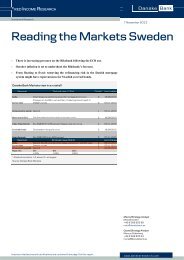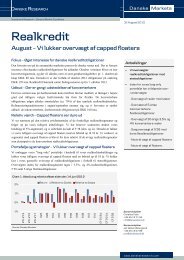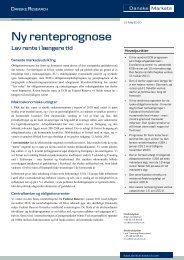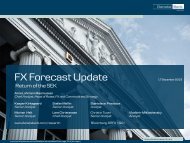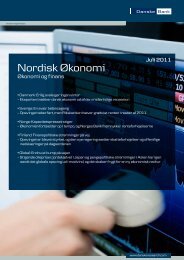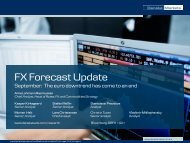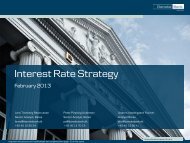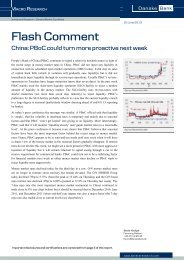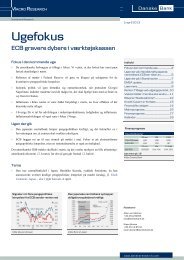Global Scenarios - Danske Analyse - Danske Bank
Global Scenarios - Danske Analyse - Danske Bank
Global Scenarios - Danske Analyse - Danske Bank
Create successful ePaper yourself
Turn your PDF publications into a flip-book with our unique Google optimized e-Paper software.
<strong>Global</strong> <strong>Scenarios</strong><br />
economy (measured in PPP) but have been driving 75% of growth in world<br />
production over the past year. The weak spot in Emerging Markets continues<br />
to be CEE where we see rising downside risk from potential spill-over from<br />
the euro debt crisis.<br />
The outlook continues to favourable, although, risks are also rising here.<br />
However, the risks are two-edged. On the one side there is the risk that a<br />
stronger negative hit from the euro crisis would put a dent on Asia as well.<br />
This speaks in favour of holding back policy tightening. However, the risk is<br />
also rising that economic policy is erring too much on the cautious side keeping<br />
stimulus for too long. The output gap is pretty much closed in most parts<br />
of Asia but policy rates are still very low. If the normalisation of rates happens<br />
too slowly there is a risk of overheating showing up either as inflation or<br />
asset price bubbles down the road. This is a risk all countries in the world are<br />
facing but it is clearly most pronounced in Asia.<br />
Fiscal tightening crowds out monetary exit<br />
The policy agenda has shifted markedly in past months as focus has turned<br />
from exit strategies to reintroducing liquidity facilities to support the fragile<br />
financial system. As the financial system is likely to remain fragile for quite<br />
some time monetary policy normalisation has been postponed. We now look<br />
to the Fed to make the first rate hike in March 2011, while the ECB hikes<br />
will be off the agenda for a long time. We look for the first hike from the<br />
ECB in H2 11. Another reason for monetary policy tightening being delayed<br />
is the more urgent need for a fiscal exit, which will dent growth and thus<br />
“crowd out” monetary exit. We see a risk that we fall into the trap again that<br />
created the problems in the first place: that monetary policy stays loose for<br />
too long due to the fragility of the recovery with the risk that new problems<br />
are created for the future as interest-rate sensitive sectors move to an unsustainable<br />
path – or bubble if you like. This risk is most pronounced in Asia as<br />
the need for policy tightening is strongest here.<br />
Asia give massive support to Euroland exporters<br />
and is by far the most important region<br />
30.0 EUR, bn EUR, bn<br />
Asia<br />
25.0<br />
20.0<br />
15.0<br />
10.0<br />
5.0<br />
Source: Reuters Ecowin<br />
Road map for sustainability vs double-dip<br />
Key drivers to watch to gauge sustainability:<br />
CEE<br />
US<br />
00 02 04 06 08 10<br />
1. Labour market: US payrolls should grow 200,000-<br />
250,000 in coming quarters. Unemployment to decline<br />
gradually.<br />
30.0<br />
25.0<br />
20.0<br />
15.0<br />
10.0<br />
2. Confidence: Business confidence is expected to level-off<br />
from the current high levels but in a gradual manner. ISM<br />
to reach 54-55 by year-end (currently 60.4). We look for<br />
consumer confidence to be unchanged or rise slightly on<br />
an improved labour market.<br />
3. Fiscal sustainability: Although fiscal issues are expected<br />
to stay high on the agenda an escalation of the confidence<br />
crisis involving US and UK should be avoided.<br />
4. Risk markets: We should avoid much further decline in<br />
equity and credit markets, as this could lead to a negative<br />
confidence spiral.<br />
5. Asian growth: Should continue at a robust pace as it is an<br />
important demand engine for the world economy not<br />
least for Euroland exports and commodity exporters.<br />
5.0<br />
Expectations on key figures and central banks over coming quarter<br />
Country Indicator Comment Measure Latest Sep/Q3<br />
Euroland GDP Economic recovery will take GDP growth slightly above trend in the coming quarters % q/q, AR 0.8% 2.1%<br />
PMI PMIs have probably peaked, but momentum will remain robust in the coming months Index 56.2 54.3<br />
Inflation Limited inflationary pressures due to large economic slack % y/y 1.6% 1.6%<br />
ECB The ECB has re-engaged in credit easing. ECB will thus keep rates on hold until H2 11 % p.a. 1.00% 1.00%<br />
Germany Ifo The German recovery looks very robust for the coming quarters Index 99.4 103.0<br />
USA GDP GDP growth will remain above trend trough 2010 % q/q, AR 3.0% 3.3%<br />
ISM ISM will soon peak, but continue to indicate above trend growth through H2 Index 60.4 57.0<br />
Employment Job growth will continue to expand at a robust pace 3 mth. mavg. 186K 225K<br />
Core inflation Core inflation will trend lower as slack in the labour market continues to build % y/y 0.9% 0.6%<br />
Federal Reserve Fed on hold. Expected to tighten rethoric in H2 % p.a. 0.13% 0.13%<br />
Japan GDP Pace of the recovery will lose some steam in H2 2010 but remain above trend % q/q, AR 4.9% 2.2%<br />
PMI Manufacturing activity will continue to improve but loose some momentum Index 54.7 53.0<br />
Inflation Deflationary pressure will gradually ease on the back of the strong recovery % y/y -1.5% -0.9%<br />
BoJ BoJ on hold until H2 2011, further non-conventional easing cannot be ruled out % p.a. 0.10% 0.10%<br />
Source: <strong>Danske</strong> Markets<br />
7 | June 2010<br />
www.danskeresearch.com



